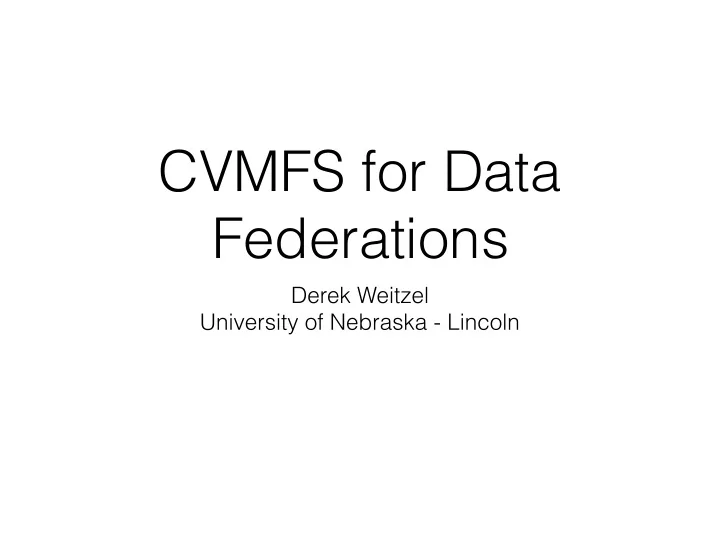

CVMFS for Data Federations Derek Weitzel University of Nebraska - Lincoln
Problem with Data Federations • Users must know the exact filenames for each job. • They have to use special tools they are unfamiliar with in order to use it (such as xrdcp or stashcp ). • Applications may only talk POSIX. • They are difficult to setup for opportunistic VO’s; OSG has already created one StashCache.
Changes to CVMFS • As discussed in Brian’s talk on yesterday, changes in CVMFS developed by him and I have enabled CVMFS’s use in data federations. • CVMFS can now access data federations through HTTP gateways. • Metadata (catalogs) come from the normal OASIS Stratum-1 infrastructure. • Data files come from the data federation.
Changes to CVMFS • File accesses can be redirected to another server • Files that are retrieved from this other server are not in standard CVMFS hashed’ format • Rather, they are uncompressed . • Instead they are pointers to a file on another server, i.e. a XRootD server.
Repositories • nova.osgstorage.org - Repo from XrootD data source at FNAL • stash.osgstorage.org - Repo built from user accessible storage at OSG-Connect • cms.osgstorage.org - Repo of the CMS data federation • ligo.osgstorage.org - Repo of LIGO data stored at Nebraska
Repositories • nova.osgstorage.org - Repo from XrootD data source at FNAL • stash.osgstorage.org - Repo built from user accessible storage at OSG-Connect • cms.osgstorage.org - Repo of the CMS data federation • ligo.osgstorage.org - Repo of LIGO data stored at Nebraska
stash.osgstorage.org 1. At a CVMFS repo, HTCondor cron job scans the Stash filesystem at UChicago, recording differences since last scan. • This looks at the contents of /stash/$USER/ public found on OSG-Connect. 2. Job puts records files’ metadata (size, checksum) into the CVMFS repository server. Data stays on Stash. 3. CVMFS repository is published with new contents.
StashCache stashcache.github.io • Managing data opportunistically at storage elements requires a CMS- or ATLAS-sized commitment. • StashCache uses distributed caches across the country. • Data origin is the Stash service on OSG-Connect. • Users write data into Stash, and read the data from jobs through StashCache For a full overview of StashCache, see Brian’s talk from last years AHM.
Overview of CVMFS and StashCache StashCache Federation • Regular XrootD StashCache CVMFS Repository Stash Origin Site Server Federation Actual Data StashCache Files (XrootD) Redirector Metadata • CVMFS contacts the caching servers over HTTP XrootD StashCache StashCache StashCache StashCache Server Server Server • Caching servers contact the federation for the data Standard Site HTTP HTTP • Worker nodes pull data from Worker Node Worker Node the caching servers CVMFS CVMFS
Uses • Large datasets which cannot be cached with Squid • Full Blast Db’s • Nova Flux Files… • Targeting working set sizes* from 10GB to 10TB. Will work fine for smaller sizes, but OASIS may be more efficient for distribution. *Number of unique bytes touched in 24 hours
User Perspective • Copies data onto OSG-Connect using scp , Globus Online - pick your favorite. • Put data into /stash/<user>/public • Wait for a while for the data to be published (~1 hr) • Use data on the worker nodes!
Stash -> CVMFS Delay • There is a delay between when the file has been created, and when the it appears in CVMFS. Cumulative Distribution of the CVMFS Publish Delay 100% Probability of File Existance 75% 50% 25% 0% 0.0 0.5 1.0 1.5 2.0 2.5 Delay in Hours
Stash -> CVMFS Delay • In 1 hour, the files are largely available Cumulative Distribution of the CVMFS Publish Delay 100% Probability of File Existance 75% 50% 25% 0% 0.0 0.5 1.0 1.5 2.0 2.5 Delay in Hours
CVMFS + StashCache • This creates a global read-only filesystem • Originally, a select few could put data into cvmfs using services such as Oasis • Now, everyone with can add their own files and software into CVMFS • Access at /cvmfs/stash.osgstorage.org/
ligo.osgstorage.org • stash.osgstorage.org is unauthenticated access to public files • LIGO has very specific rules about data access and even namespace visibility • Therefore, had to develop new features in CVMFS to enable VOMS authentication.
Secure CVMFS • Pull certificate from the user’s environment • Namespace is protected by authenticated access to CVMFS HTTP(S) server. • Data is authenticated with XRootD HTTP(S) client authentication.
Secure CVMFS • Special setup of HTTP server for authenticate setup (mod_gridsite) • XrootD serves data directly from data servers, cannot currently proxy authenticated access.
What you can do! • Update CVMFS on your worker nodes to 2.2 preview: yum install --enablerepo=osg-upcoming cvmfs cvmfs-config-osg • Feel free to install this locally and test the interface on OSG-Connect. • Requires sites to upgrade their CVMFS client: widespread availability will probably occur in July.
Recommend
More recommend